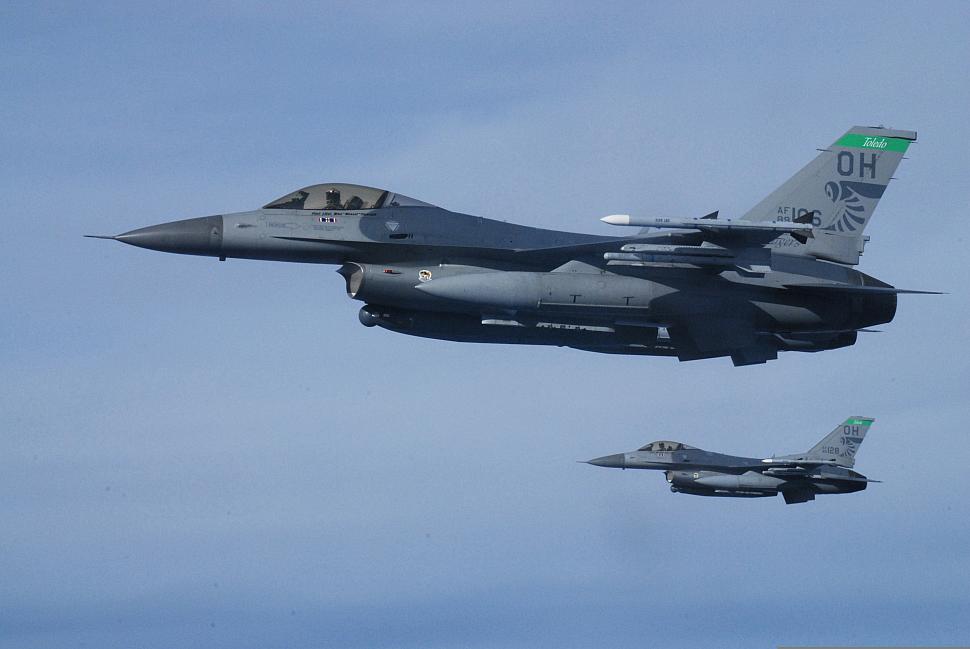Fighter Jet News
F-16 Fighting Falcon News
Stingers fly high with Bio-fuel
January 12, 2012 (by
MSgt. Beth Holliker) -
The 180th Fighter Wing is known for leaning forward in the research, development and implementation of green energy programs. The wing marked yet another environmentally friendly milestone Tuesday as one of its F-16CM fighting falcons successfully flew a routine training mission fueled solely on bio-fuel.
Though the Jan. 10 training mission is a first for the 180th, the use of this green fuel is not a first for the U.S. Air Force. Planning to certify more than 40 aircraft models by 2016, the Air Force has been testing bio-fuels, sometimes referred to as Hydro-processed Renewable Jet Fuel, in many of its fighter and cargo airframes since 2009.
The U.S. Air Force Thunderbirds flight demonstration team put the alternative blended-fuel to the test, with one of the F-16s successfully demonstrating extreme manoeuvres including loops and barrel-rolls for the first time during an air show in May 2011.
"The 180th Fighter Wing is known for taking an aggressive role in ensuring renewable energy is brought to the forefront of our nation's defense," said Col. Bill Giezie, Mission Support Group Commander for the 180th Fighter Wing, when asked about the wing's selection as part of this bio-fuel evaluation process. "It is only natural that the wing would continue to be engaged in aggressively pursuing renewable fuel options for our aircraft."
Two F-16s from the 180th Fighter Wing's fleet have been designated to test 100,000 gallons of the renewable fuel over a period of several weeks as one of the final steps before taking the fuel mainstream and allowing the F-16 to use bio-fuels in unrestricted operations. The viper jets will fly day-to-day routine training missions to evaluate the performance and the effects on the engine and fuel systems.
The bio-fuel is a 50/50 blend of conventional, petroleum-based Jet Propellant 8, or JP-8 and bio-fuel derived from the Camelina plant, a weed-like plant often called wild flax. The Camelina plant grows easily throughout the United States and other areas around the world. Though the plant prefers full sun and loose, dry soil, wild flax is very adaptable and can even be used as a rotation crop with wheat.
Along with being readily available and easily grown, the production process of converting this plant into a relevant renewable fuel source emits far less greenhouse gasses than the manufacturing process of normal petroleum.
"This is another step in the right direction to develop a domestic source of sustainable energy," said Giezie. "As we remain engaged in pursuing relevant renewable energy sources, we can continue to increase our national energy security while supporting our national economy."
The U.S. Air Force Thunderbirds flight demonstration team put the alternative blended-fuel to the test, with one of the F-16s successfully demonstrating extreme manoeuvres including loops and barrel-rolls for the first time during an air show in May 2011.
"The 180th Fighter Wing is known for taking an aggressive role in ensuring renewable energy is brought to the forefront of our nation's defense," said Col. Bill Giezie, Mission Support Group Commander for the 180th Fighter Wing, when asked about the wing's selection as part of this bio-fuel evaluation process. "It is only natural that the wing would continue to be engaged in aggressively pursuing renewable fuel options for our aircraft."
Two F-16s from the 180th Fighter Wing's fleet have been designated to test 100,000 gallons of the renewable fuel over a period of several weeks as one of the final steps before taking the fuel mainstream and allowing the F-16 to use bio-fuels in unrestricted operations. The viper jets will fly day-to-day routine training missions to evaluate the performance and the effects on the engine and fuel systems.
The bio-fuel is a 50/50 blend of conventional, petroleum-based Jet Propellant 8, or JP-8 and bio-fuel derived from the Camelina plant, a weed-like plant often called wild flax. The Camelina plant grows easily throughout the United States and other areas around the world. Though the plant prefers full sun and loose, dry soil, wild flax is very adaptable and can even be used as a rotation crop with wheat.
Along with being readily available and easily grown, the production process of converting this plant into a relevant renewable fuel source emits far less greenhouse gasses than the manufacturing process of normal petroleum.
"This is another step in the right direction to develop a domestic source of sustainable energy," said Giezie. "As we remain engaged in pursuing relevant renewable energy sources, we can continue to increase our national energy security while supporting our national economy."
Courtesy of 180th Fighter Wing Public Affairs
Related articles:
Forum discussion:
Tags
Forum discussion:
- Start a discussion about this article in the F-16.net forum.
Tags

